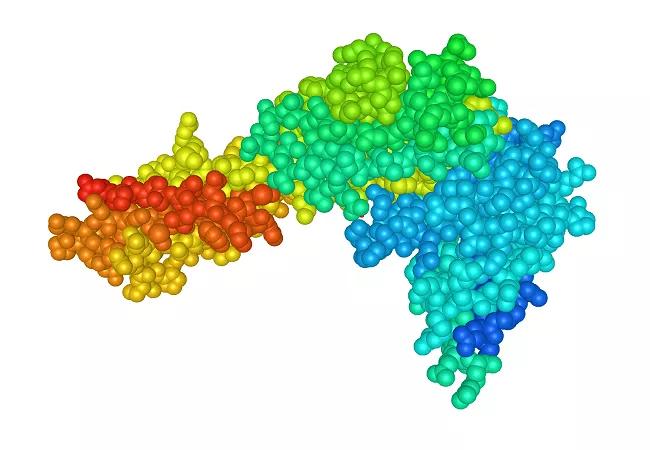This cell surface protein could be an immune checkpoint inhibition target

The immune checkpoint ligand PD-L2 is a promising new prostate cancer biomarker and therapeutic target, particularly in combination with radiotherapy, according to results of the largest high-throughput genetic analysis of its kind to date.
Cleveland Clinic is a non-profit academic medical center. Advertising on our site helps support our mission. We do not endorse non-Cleveland Clinic products or services. Policy
The recently published research reveals more about prostate cancer’s multi-faceted proliferation and defense mechanisms and the complicated interplay between tumor and immune system cells, says Eric Klein, MD, Chair of Cleveland Clinic’s Glickman Urological & Kidney Institute and a co-author of the multi-center study.
Hormone therapy to inhibit the androgen receptor and cytotoxic chemotherapy have been the mainstays of systemic prostate cancer treatment for decades. Each has significant limitations. Alternate approaches are needed.
While immunotherapy in the form of checkpoint inhibitors has produced modest successes in some prostate cancer patients, clinicians are unable to consistently predict individual response. This is due to the apparently low degree of immune penetration in prostate cancer, and an incomplete understanding of the tumor’s complex interactions with elements of the innate and adaptive immune system.
Previous investigations’ clinical applicability has been hampered by the studies’ varying cohorts, small sample sizes and lack of long-term follow-up.
The investigators in this study sought to remedy those issues and identify potential immunotherapy targets by evaluating multiple tumor/immune system variables using gene expression data from nearly 10,000 prostatectomy tissue samples. Seventeen percent of the samples were retrospective, so long-term clinical outcomes were known.
The researchers used a genome-wide assay and computational tools to estimate the samples’ relative immune content and the relative contributions of various cell types, based on gene expression patterns. They focused on seven immune cell varieties (mast cells, dendritic cells, natural killer [NK] cells, T-cells, regulatory T-cells, B-cells and macrophages), and four immune checkpoint molecules that are current immunotherapy targets (cytotoxic T-lymphocyte-associated protein 4 [CTLA-4], programmed cell death protein 1 [PD-1], and programmed death ligands 1 and 2 [PD-L1 and PD-L2]).
Those variables were assessed against the primary clinical endpoint — distant metastasis-free survival (DMFS) — and three secondary endpoints: biochemical recurrence-free survival (bRFS), prostate cancer-specific survival (PCSS) and overall survival (OS).
Molecular profiling of the prostate tumor samples showed an association between estimated total immune content and prognosis. Specifically, mast cells, NK cells and dendritic cells conferred improved DMFS, while macrophages and T-cells were related to worse DMFS. T-regulatory cells and B-cells did not display a linkage with clinical outcomes.
The T-cell finding was surprising since, broadly speaking, T-cells have been associated with improved clinical outcomes in cancers overall. A possible explanation in the case of prostate cancer, the researchers say, is that total T-cell infiltration may just indicate chronic inflammation (and thus possible oncogenicity), whereas the important measure for antitumor immunity may be the relative activation of T-cell subsets.
Gene set enrichment analysis also showed that three of the four immune checkpoint molecules studied are prognostic in prostate cancer. Elevated CTLA-4 levels were associated with worse bRFS, DMFS and PCSS, while increased PD-1 expression was related to improved bRFS, DMFS and PCSS.
One of the PD-1 receptor’s ligands, PD-L1, showed no association with clinical outcomes, probably because of its low expression in prostate cancer. However, the second known PD-1 ligand, PD-L2, conferred worse bRFS, DMFS and PCSS outcomes. Also, PD-L2 expression levels exceeded those of PD-L1 in all of the 9,393 tissue samples, particularly in those representing more aggressive tumors. Finally, PD-L2 expression was strongly correlated with immune-associated biological pathways, even though those were a small fraction of the total pathways the researchers analyzed.
Collectively, those findings indicate that PD-L2 plays a significant part in prostate cancer immune modulation and should be considered a viable prognostic biomarker as well as an immune checkpoint inhibition target, the researchers conclude.
“Immunotherapeutic approaches for prostate cancer have shown very limited success to date, and most of the agents used in other solid tumors have targeted PD-L1,” Dr. Klein says. “These new findings suggest a potential role for inhibiting PD-L2, but prospective studies will need to be done to confirm the clinical utility of this finding.”
An additional finding from the gene set enrichment analysis was that PD-L2 expression correlated with all five of the radiation response biological pathways included in the analysis. Gene sets linked with exposure to radiotherapy were enriched with genes associated with PD-L2 expression.
When the researchers reviewed clinical outcomes from this subset of the tissue samples, they found that PD-L2 appears to predict patients’ response to postoperative radiation therapy (PORT). While patients whose tumors had elevated PD-L2 expression levels fared worse than patients with low PD-L2-level tumors, the outcome difference decreased to equivalence in patients treated with PORT.
That suggests anti-PD-L2 therapy combined with PORT may benefit prostate cancer patients with aggressive tumors. Localized radiation therapy is hypothesized to “prime” the immune system to initiate a systemic antitumor response via the immune-mediated abscopal effect, which may be amplified by PD-L2 checkpoint inhibition to overcome immunoresistance in appropriately selected patients.
Image: 3-D structure of mouse PD-1/PD-L2 complex from
Lázár-Molnár E, Yan Q, Cao E, Ramagopal U, Nathenson SG, Almo SC. Crystal structure of the complex between programmed death-1 (PD-1) and its ligand PD-L2. Proc Natl Acad Sci U S A. 2008;105(30):10483–10488. ©2008 National Academy of Sciences.

An underdiagnosed condition in patients with cancer

Study demonstrates superior visualization of occult primary lesions

New device offers greater tumor control for malignant liver lesions

Cleveland Clinic researchers discover what drives – and what may halt – virus-induced cancer

First-ever U.S. population-level retrospective analysis reveals many patients with systemic mastocytosis need faster intervention

New program provides prehabilitation and rehabilitation services to help patients with cancer maintain and regain function

First-of-its-kind research investigates the viability of standard screening to reduce the burden of late-stage cancer diagnoses

Global R&D efforts expanding first-line and relapse therapy options for patients